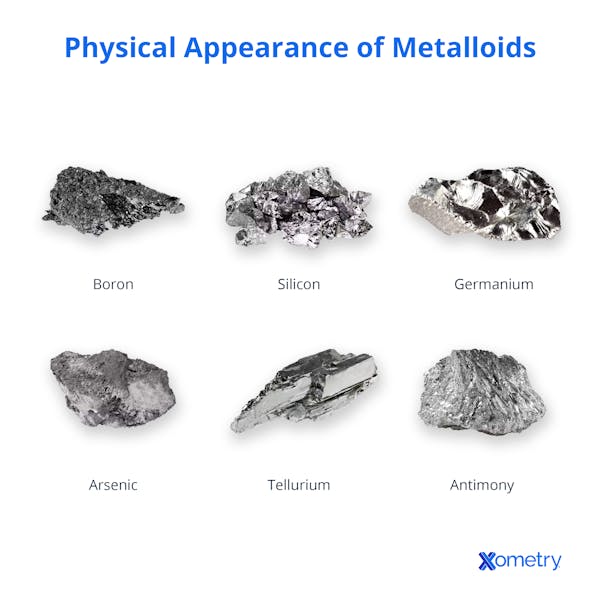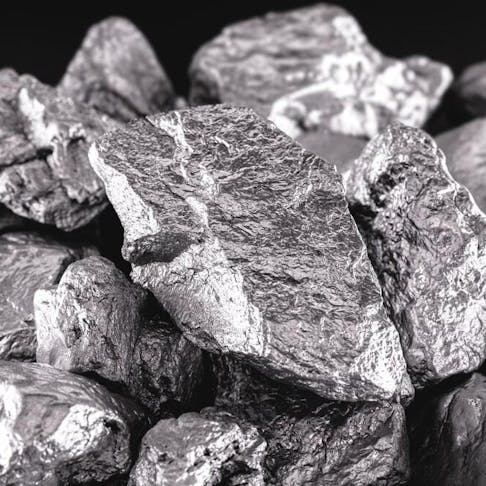Metalloids are a unique and versatile class of elements. Also known as “semimetals,” metalloids are typically found in a zigzag line on the periodic table, sandwiched between metals and nonmetals. Although they have a metallic appearance, metalloid elements can exhibit properties that are like those of metals or nonmetals. The degree to which metalloids exhibit metallic or non-metallic characteristics depends on the element.
This article will discuss the seven metalloid elements, their attributes, and their uses.
| Properties | Uses |
|---|---|
Properties - Pure crystalline Boron has a black, lustrous color and is extremely hard. - Boric acid and borates are safe for animals and toxic to arthropods, but essential for plant growth. | Uses - Used as an additive to harden steels and glass. - Boron-based compounds are used as insecticides and fertilizers. |
| Properties | Uses |
|---|---|
Properties - Has the ability to form up to 3 covalent bonds, allowing it to easily bond with many metals. - Highly toxic to animals and plants when formed into an arsine or other organic derivatives, but inert in its elemental form. | Uses - Can be used as an additive to harden lead and other metal alloys. - Used in some herbicides and insecticides and as a wood preservative. |
| Properties | Uses |
|---|---|
Properties - Pure silicon is highly reactive in nature and its derivatives are often found in sands, rocks, and soils. - Has poor electrical conductivity that becomes more efficient at higher temperatures. | Uses - Commonly used in semiconductors. - Used in the manufacturing of alloys, glass, enamels, and other ceramics. |
| Properties | Uses |
|---|---|
Properties - Has a silvery-white, metallic appearance. - Hard and brittle . - Highly purified antimony has a poor electrical conductivity that improves with increased temperatures. | Uses - Used in semiconductors as a dopant. - Used in the manufacture of alloys, glass, enamels, and other ceramics. |
| Properties | Uses |
|---|---|
Properties - Is highly rare and can be found in mined ores. - Is crystalline and brittle. - Remains stable in water but dissolves in nitric acid. | Uses - Is often used as an additive to improve strength and corrosion resistance in certain alloys. |
| Properties | Uses |
|---|---|
Properties - Is hard and brittle with a metallic appearance. - Has poor electrical conductivity that becomes more efficient at higher temperatures. | Uses - Is used as an additive to improve corrosion resistance in certain alloys. - Is often used in semiconductors and infrared detectors. |

Frequently Asked Questions About Metalloid Elements
Where on the Periodic Table Can We Find the Elements of Metalloids?
The metalloid elements are found along the “zigzag,” or “staircase” of elements lying between the metals and the nonmetals on the periodic table. They are concentrated in the upper-right portion of the table.
How Are Elements Classified as Metalloids?
Elements that exhibit both metal and nonmetal characteristics, but not solely one or the other, are typically classified as metalloid elements. They are also classified as metalloids based on their ionization energies and electronegativities. These two characteristics flow form the number of valence electrons present in a given type of atom. As you move from left to right on the periodic table, elements become more reactive. Metalloid elements are unique in that when they react with different elements, they sometimes behave like metals and sometimes behave like nonmetals - depending on the element that is reacted with. There is much debate within the scientific community regarding exactly which elements should be considered metalloids. For instance, some scientists may consider selenium (Se) a metalloid, while others would not.
What is the Significance of Categorizing Elements into Metalloids?
The significance of categorizing elements into the category of metalloids is that it allows scientists, chemists, and engineers to predict the properties and reactivity of particular elements. Organizing metalloid elements based on their numbers of valence electrons and material properties makes it much easier.
Are Metalloids Valuable in the Electronics Industry?
Yes, metalloid elements, particularly silicon (Si) and germanium (Ge) are exceptionally valuable in the electronics industry. Without their presence, many of the high-tech and “smart” devices we’re accustomed to today would not be possible. Si and Ge are commonly used as semiconductors. The electrical conductivity of these two elements increases with temperature and with the concentration of impurities added to the base semiconductor through a process called "doping."
As ambient temperature increases, the conductivity of these elements decreases. This makes them excellent conductors at increased temperatures, but insulators at lower temperatures. Doping affects the potential conductivity of Si and Ge by introducing atoms of a different element into their crystalline structure. Doped materials, called “extrinsic semiconductors,” can have different electrical properties than pure semiconductors, which are called “intrinsic semiconductors.” There are two different types of dopants: p-type, or electron acceptors, and n-type, or electron donors, that create p-type and n-type semiconductors. The element used as a doping agent dictates the type of semiconductor that is created.
When coupling doping with increased ambient temperatures, semiconductors can be used to amplify particular electrical currents. Extrinsic semiconductors formed from metalloid elements and their dopants are instrumental in the manufacture of electronic control devices such as: bipolar junction transistors (BJT), field-effect transistors (FET), and metal-oxide semiconductors (MOSFET). Semiconductors are used in many devices we use every day - from temperature sensors to calculators, to solar panels, to computers. None of this would be possible without the presence of metalloid elements.
How Xometry Can Help
This article reviewed a summary of the key properties and uses of 7 common metalloid elements.
Xometry provides a wide range of manufacturing capabilities and value-added services for all of your prototyping and production needs. Visit our website to learn more or to request a free, no-obligation quote.
Disclaimer
The content appearing on this webpage is for informational purposes only. Xometry makes no representation or warranty of any kind, be it expressed or implied, as to the accuracy, completeness, or validity of the information. Any performance parameters, geometric tolerances, specific design features, quality and types of materials, or processes should not be inferred to represent what will be delivered by third-party suppliers or manufacturers through Xometry’s network. Buyers seeking quotes for parts are responsible for defining the specific requirements for those parts. Please refer to our terms and conditions for more information.

